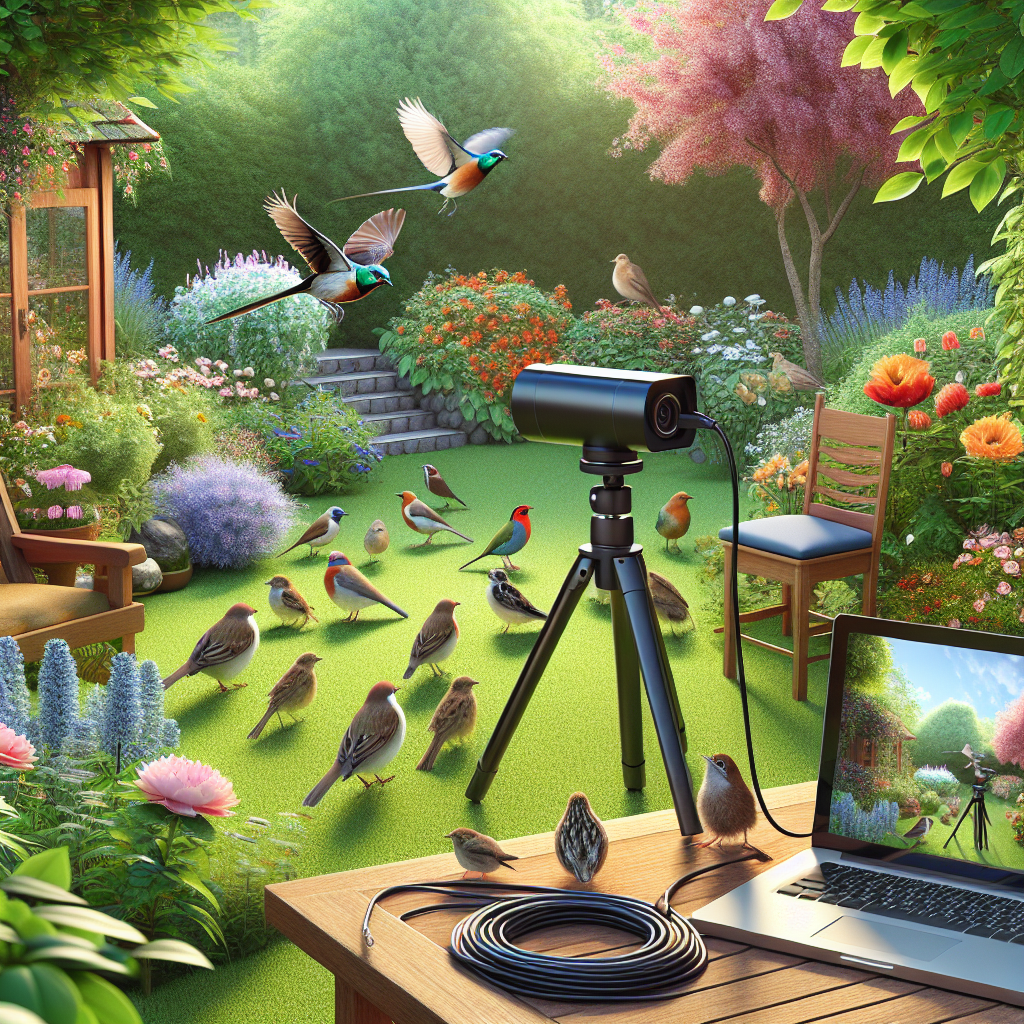Imagine capturing the beauty of birds up close and personal, without even leaving the comfort of your own home. With a live webcam, you can turn your backyard into a bird paradise and enjoy the fascinating world of bird watching from a whole new perspective. In this article, we will guide you through the steps to set up your very own live webcam for bird watching, helping you bring the wonder of nature right to your screens. So get ready to embark on an exciting journey of discovery and immerse yourself in the captivating world of bird watching like never before.

Choosing the Right Webcam
Resolution
When choosing a webcam for bird watching, it’s important to consider the resolution. A higher resolution will provide clearer and more detailed images, allowing you to see the birds in all their beauty. Look for webcams with resolutions of at least 720p or higher for the best results.
Frame Rate
The frame rate of a webcam determines how smooth the video playback will be. For bird watching, it’s recommended to choose a webcam with a higher frame rate, ideally 30 frames per second (fps) or higher. This will ensure that you capture all the fast-paced movements of the birds without any choppiness.
Field of View
The field of view is the area that the webcam can capture in a single frame. For bird watching, it’s beneficial to have a wide field of view to capture a larger area and increase the chances of capturing birds in the frame. Look for webcams with a field of view of at least 90 degrees or more for optimal coverage.
Selecting the Best Location
Outdoor Placement
To have the best bird watching experience, it’s essential to place the webcam outdoors. Choose a location that offers a clear and unobstructed view of the bird activity. Avoid areas with too much direct sunlight as it can cause glare and affect the quality of the footage.
Angle and View
When positioning the webcam, consider the angle and view you want to capture. Aim the webcam towards bird feeders, bird baths, or any other areas where birds frequently gather. Experiment with different angles to find the best perspective that showcases the birds’ behaviors and interactions.
Protection from Elements
To ensure the longevity of your webcam, it’s crucial to protect it from the elements. Consider installing a protective case or housing that shields the camera from rain, wind, and extreme temperatures. This will help maintain the quality of the footage and prevent any damage to the webcam.
Setting Up Power Source and Internet Connection
Power Source
To power your webcam, it’s essential to have a reliable power source. Consider using an outdoor electrical outlet or an extension cord specifically designed for outdoor use. Alternatively, you can opt for a solar-powered webcam that harnesses energy from the sun, providing a sustainable and eco-friendly power solution.
Internet Connection
For a live webcam feed, a stable internet connection is crucial. Ensure that you have a strong Wi-Fi signal in the area where you plan to install the webcam. If your Wi-Fi signal is weak, consider using a Wi-Fi range extender to boost the signal strength and ensure a consistent connection.
Wi-Fi Range Extender
If your chosen location is far from your existing Wi-Fi network, a Wi-Fi range extender can come in handy. This device extends the range of your Wi-Fi signal, allowing you to connect your webcam to the network even from a distance. Choose a high-quality range extender that is compatible with your router for optimal performance.
Installing and Configuring the Webcam Software
Downloading and Installing
Once you have chosen your webcam, you will need to download and install the accompanying software. Visit the manufacturer’s website and locate the webcam model to find the appropriate software. Follow the provided instructions to install it on your computer.
Configuring Settings
After installing the software, you will need to configure the settings for your webcam. This includes adjusting the resolution, frame rate, and field of view based on your preferences. Additionally, you can customize settings such as motion detection, scheduling, and video recording options to enhance your bird watching experience.
Test and Troubleshooting
Before mounting the webcam, it’s crucial to test its functionality and troubleshoot any issues. Ensure that the webcam is properly connected to your computer and that the software recognizes it. Test the video and audio quality, as well as any additional features you have configured. If any issues arise, refer to the manufacturer’s troubleshooting guide or contact their customer support for assistance.

Mounting the Webcam
Tripod Mount
A tripod mount provides a versatile and stable mounting option for your webcam. Attach the webcam to a tripod with a compatible mount and adjust the height and angle as desired. Tripods offer the flexibility to reposition the webcam easily and capture different perspectives of the bird activity.
Wall Mount
If you prefer a fixed position for your webcam, a wall mount is a suitable option. Choose a sturdy location on a wall or post where you have a clear view of the bird activity. Securely mount the webcam and adjust the angle to capture the desired area. Ensure that the wall mount is firmly attached for stability and durability.
Branch Mount
For a more natural and discreet placement, consider using a branch mount. Attach the webcam to a sturdy branch using zip ties or clamps, positioning it in a way that blends with the surrounding foliage. This allows you to get closer to the birds and capture their natural behavior without disturbing their habitat.
Creating a Bird-Friendly Environment
Feeders and Birdhouses
To attract a wide variety of birds to your webcam, set up bird feeders and birdhouses in the surrounding area. Different bird species have various feeding preferences, so offer a variety of feeders and food options such as seeds, nectar, and suet. Provide nesting boxes or birdhouses to encourage birds to make your garden their home.
Bird Baths
Birds need water for drinking and bathing, so a bird bath is a valuable addition to your bird-friendly environment. Ensure the bird bath is shallow and has a rough surface to provide a secure footing for the birds. Place it near the webcam, allowing you to capture delightful moments of birds splashing and preening.
Plants and Landscaping
Create a diverse and natural habitat by planting a variety of native plants and trees. These provide food sources, shelter, and nesting places for birds. Consider including flowering plants to attract hummingbirds and butterflies, adding colors and beauty to your bird watching experience. Avoid using pesticides or chemicals that could harm the birds or their habitat.
Positioning and Adjusting the Webcam
Fine-tuning the Angle
Once your webcam is mounted, take the time to fine-tune the angle to enhance your bird watching experience. Adjust the webcam to capture the desired field of view, ensuring that it frames the bird activity without unnecessary distractions. Experiment with different angles to find the perfect perspective that showcases the birds’ natural behavior.
Avoiding Glare and Reflections
Glare and reflections can reduce the clarity of the footage and obscure the birds’ visibility. Consider the position of the webcam in relation to the sun and other light sources to minimize glare. Use an anti-glare filter or adjust the angle of the webcam slightly to avoid unwanted reflections and ensure optimal viewing conditions.
Testing for Optimal View
Before starting your live webcam feed, conduct a thorough test to ensure that you have an optimal view. Watch the footage to see if any adjustments need to be made. Pay attention to the lighting, clarity, and overall composition of the frame. Fine-tune the position and angle of the webcam until you are satisfied with the view.
Monitoring and Recording Bird Activity
Software for Live Viewing
The webcam software provides options for live viewing of the bird activity. Take advantage of these features to keep an eye on the birds in real-time. Monitor their behaviors, interactions, and feeding patterns from the comfort of your computer. You can even capture screenshots or short videos of interesting moments to share with others.
Recording Options
Recording the bird activity allows you to create a personal archive of memorable moments and interesting behaviors. Check if your webcam software offers recording options, such as continuous recording or motion-based recording. Customize the settings to capture only relevant footage and conserve storage space. Remember to regularly review and organize your recordings for easy access.
Accessing Webcam Remotely
If you want to enjoy your bird watching experience from anywhere, consider setting up remote access to your webcam. This allows you to view the live feed and control the webcam’s settings from your smartphone or computer, regardless of your location. Check if your webcam software offers remote access functionality and follow the instructions to set it up securely.
Troubleshooting and Maintenance
Common Issues and Solutions
Despite careful setup, you may encounter common issues with your webcam. Problems such as poor video quality, connection dropouts, or software malfunctions can occur. Refer to the troubleshooting guide provided by the manufacturer or consult online resources for solutions. Updating the webcam software or firmware may also resolve certain issues.
Regular Cleaning and Maintenance
To maintain the quality of your footage, it’s important to regularly clean your webcam. Use a soft, lint-free cloth to remove any dirt or dust from the lens and other external surfaces. Avoid using harsh chemicals or abrasive materials as they can damage the camera. Additionally, regularly check and clean the bird feeders, bird baths, and the surrounding area to ensure a pleasant bird-friendly environment.
Updating Software and Firmware
Stay up to date with the latest software and firmware updates for your webcam. Manufacturers often release updates to improve performance, fix bugs, and introduce new features. Check the manufacturer’s website regularly for updates and follow the instructions to install them. Keeping your webcam software and firmware updated ensures that you have the best user experience and access to the latest functionalities.
Sharing and Enjoying Bird Watching Moments
Sharing on Social Media
Impress your friends, family, and fellow bird enthusiasts by sharing your bird watching moments on social media. Post captivating photos or videos of interesting bird behaviors, remarkable sightings, or beautiful landscape shots. Consider joining bird watching groups or communities online to connect with like-minded individuals and exchange valuable insights.
Inviting Others to Watch
Spread the joy of bird watching by inviting others to watch your live webcam feed. Share the link to your webcam with friends, family, or local bird watching organizations. Arrange gatherings or online events where you can all enjoy the birds’ activities together and engage in lively discussions. It’s a fantastic way to foster a sense of community and promote the appreciation of nature.
Learning and Identifying Bird Species
Embrace the educational aspect of bird watching by learning about different bird species. Use your webcam footage to identify and study the birds that visit your feeders or bird baths. Invest in field guides or use online resources to help you recognize various species based on their appearance, calls, and behaviors. Engage in bird identification challenges or take part in citizen science projects to contribute to bird conservation efforts.
In conclusion, setting up a live webcam for bird watching requires careful consideration and planning. By choosing the right webcam, selecting a suitable location, ensuring a reliable power source and internet connection, installing and configuring the webcam software, mounting the webcam securely, creating a bird-friendly environment, positioning and adjusting the webcam, monitoring and recording bird activity, troubleshooting and maintaining the webcam, and finally, sharing and enjoying the bird watching moments, you can immerse yourself in the fascinating world of birds from the comfort of your own home. Enjoy the beauty of nature and the wonders of bird watching while creating lasting memories and connecting with fellow bird enthusiasts. Happy bird watching!

